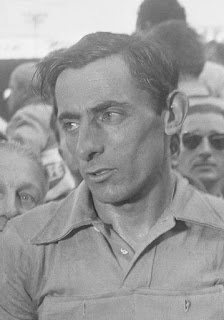Lion of Mugello won both Tour de France and Giro d’Italia
 |
| Gastone Nencini in buoyant mood after winning the Tour de France in 1960 |
Nencini won the 1957 Giro d’Italia and the 1960 Tour de
France, putting him in the company of only seven Italians to have won the
greatest of cycling’s endurance tests.
He followed Ottavio Bottecchia, Gino Bartali and Fausto Coppi
and preceded Felice Gimondi, Marco Pantani and the most recent winner, 2014
champion Vincenzo Nibali.
Yet often even cycling fans asked to name the seven Italian
champions sometimes forget Nencini, despite his courage and resilience earning
him the nickname The Lion of Mugello.
This may be in part because he died very young, a month
short of his 50th birthday, after developing a rare disease of the
lymphatic system. Others, in particular
members of his family, believe it was his maverick nature, his refusal to
comply with the sport’s etiquette, that damaged his reputation.
In his era, some claim, there were unwritten rules in
cycling by which the so-called domestiques – i.e. those not expected to be in
contention for honours – would ride purely for the benefit of their team,
giving the best riders maximum chance of success.
 |
| Rival rider Fausto Coppi was accused of plotting against Nencini |
This was evident in 1955, in only his second year as a
professional, when he put himself in a position to win the Giro d’Italia
against the odds, in a field that included three previous champions in Hugo
Koblet, Fiorenzo Magni and the five-times winner Coppi.
His family believed that Magni and Coppi were part of a
conspiracy on the penultimate stage, the 216km (134 miles) leg from Trento to
San Pellegrino Terme, when Nencini suffered multiple punctures but often found
the support vehicles were slow to be on hand, meaning that wheel changes, often
completed in as little as 15 seconds, sometimes cost him more than a minute.
The two champions drove on hard whenever Nencini had to
stop, with the result that Coppi won the stage and Magni regained his place as
race leader, which he kept over the final stage into Milan.
Two years later, with both Coppi and Magni absent, Nencini
took the title, this time benefitting from a feud between the defending
champion, Luxemburg’s Charly Gaul, and the Frenchman Louison Bobet, which saw
Gaul determined to wear down Bobet in the closing stages, enabling Nencini
to claim the title.
 |
| Nencini leads the field in the 1960 Giro d'Italia |
Only the Frenchman Henry Anglade was a match for Nencini in
a descent. He had come out on top in a one-to-one challenge down an Italian
mountain in 1959 but had warned Rivière not to attempt to emulate him.
After quitting competitive racing, Nencini, whose
free-spirited, anti-authority nature also extended to smoking cigarettes and
drinking wine with dinner even during races, owned a bike shop and indulged his
talent for painting, taking lessons from Pietro Annigoni, who had painted
portraits of Queen Elizabeth II, Pope John XXIII and President John F Kennedy
among others.
He died in hospital in Florence in February, 1980. His memory
has been honoured with a plaque mounted on a wall by the roadside at the Futa
Pass, which has been part of a Giro d’Italia stage that passes close by Barberino.
Travel tip:
 |
| The Castle of Cafaggiolo was a Medici summer residence |
 |
| The Giro d'Italia traditionally finished with the riders entering the Arena Civica, the neoclassical amphitheatre |
The Giro d’Italia of today has stages outside Italy – this
year, for example, it will start in Jerusalem, in Israel – but traditionally it
began and finished in Milan, the riders setting off from Piazzale Loreto and
finishing at the Arena Civica, the neoclassical amphitheatre inside the Parco
Sempione, behind the Castello Sforzesco. The stadium, commissioned by Napoleon
Bonaparte soon after he became King of Italy in 1805, was at one time the home
of the Milan football club Internazionale. Known nowadays as the Arena Gianni
Brera, named after Italy’s most famous football journalist, it is a venue for
international athletics, also hosting rugby union as well as Milan's third
football team, Brera Calcio FC.
More reading:
The tragedy of Marco Pantani
Alfredo Binda - the champion so good he was paid not to race
Gino Bartali - cycling's secret war hero
Also on this day:
1773: The death of Luigi Vanvitelli, designer of the Royal Palace in Caserta and the backdrop to the Trevi Fountain in Rome
1869: The birth of sculptor Pietro Canonica
1926: The birth of movie star Cesare Danova
Selected reading:
Giro d'Italia: The Story of the World's Most Beautiful Bike Race, by Colin O'Brien
Pedalare! Pedalare! A History of Italian Cycling, by John Foot
(Nencini by Harry Pot; 1960 Giro from Dutch National Archives; Coppi by J.D.Noske; Castle by Massimilianogalardi; all via Wikimedia Commons)
More reading:
The tragedy of Marco Pantani
Alfredo Binda - the champion so good he was paid not to race
Gino Bartali - cycling's secret war hero
Also on this day:
1773: The death of Luigi Vanvitelli, designer of the Royal Palace in Caserta and the backdrop to the Trevi Fountain in Rome
1869: The birth of sculptor Pietro Canonica
1926: The birth of movie star Cesare Danova
Selected reading:
Giro d'Italia: The Story of the World's Most Beautiful Bike Race, by Colin O'Brien
Pedalare! Pedalare! A History of Italian Cycling, by John Foot
(Nencini by Harry Pot; 1960 Giro from Dutch National Archives; Coppi by J.D.Noske; Castle by Massimilianogalardi; all via Wikimedia Commons)



